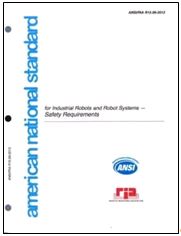
ANSI/RIA R15.06-2012 / Industrial Robots and Robot Systems- Safety Requirements
ID 2121 | Update news 15.03.2024 / Preview attached
The objective of this standard is to enhance the safety of personnel using industrial robots and industrial robot systems by establishing requirements for the manufacture, integration, installation and safeguarding of industrial robots.
Approved March 28, 2013. 160 Pages. A revision of ANSI R15.06-1999, this standard provides guidelines for the manufacture and integration of Industrial Robots and Robot Systems with emphasis on their safe use, the importance of risk assessment and establishing personnel safety. This standard is a national adoption of the International Standards ISO 10218-1 and ISO 10218-2 for Industrial Robots and Robot Systems, and offers a global safety standard for the manufacture and integration of such systems.
_______
Part 1 – Industrial] Robots
This standard has been created in recognition of the particular hazards that are presented by industrial robots and industrial robot systems.
This part of [the standard] is a type C standard as outlined in ISO 12100. When provisions of a type-C standard are different from those which are stated in type-A or type-B standards, the provisions of the type-C standard take precedence over the provisions of the other standards for machines that have been designed and built in accordance with the provisions of the type-C standard.
The machinery concerned and the extent to which hazards, hazardous situations and events are covered are indicated in the Scope of this part of [the standard]. Hazards associated with robots are well recognized, but the sources of the hazards are frequently unique to a particular robot system.
The number and type(s) of hazard(s) are directly related to the nature of the automation process and the complexity of the installation.
The risks associated with these hazards vary with the type of robot used and its purpose, and the way in which it is installed, programmed, operated and maintained.
NOTE - Not all of the hazards identified by [this standard] apply to every robot, nor will the level of risk associated with a given hazardous situation be the same from robot to robot.
Consequently, the safety requirements, or the protective measures, or both, can vary from what is specified in [this standard]. A risk assessment can be conducted to determine what the protective measures should be. In recognition of the variable nature of hazards with different uses of industrial robots, [this standard] is divided into two parts.
This part of [the standard] provides guidance for the assurance of safety in the design and construction of the robot.
Since safety in the application of industrial robots is influenced by the design and application of the particular robot system integration,
Part 2 of this standard provides guidelines for the safeguarding of personnel during robot integration, installation, functional testing, programming, operation, maintenance and repair.
This part of the standard has been updated based on experience gained in developing the Part 2 guidance on system and integration requirements, in order to ensure it remains in line with minimum requirements of a harmonized type-C standard for industrial robots.
Revised technical requirements include, but are not limited to, definition and requirements for singularity, safeguarding of transmission hazards, power loss requirements, safety-related control circuit performance, addition of a category 2 stopping function, mode selection, power and force limiting requirements, marking, and updated stopping time and distance metric and features.
This part of the standard is not applicable to robots which were manufactured prior to its publication date.
....
ANSI/RIA R15.06-2012
American National Standard for Industrial Robots and Robot Systems- Safety Requirements (revision of ANSI/RIA R15.06-1999)
add preview attach
Collegati
Allegati
|
Descrizione |
Lingua |
Dimensioni |
Downloads |
 |
|
EN |
314 kB |
5 |


































